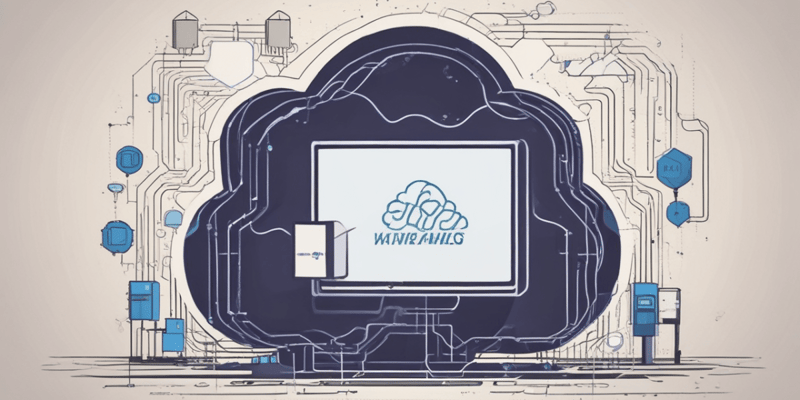Podcast
Questions and Answers
What is the primary function of AWS Cloud Adoption Framework (CAF)?
What is the primary function of AWS Cloud Adoption Framework (CAF)?
Which of the following challenges is associated with moving to the cloud?
Which of the following challenges is associated with moving to the cloud?
How does the AWS Cloud Adoption Framework (CAF) help in boosting innovation?
How does the AWS Cloud Adoption Framework (CAF) help in boosting innovation?
Which statement best describes the 'Envision' step in the AWS Cloud Adoption Framework?
Which statement best describes the 'Envision' step in the AWS Cloud Adoption Framework?
Signup and view all the answers
Which of the following is NOT a key capability of the AWS Cloud Adoption Framework?
Which of the following is NOT a key capability of the AWS Cloud Adoption Framework?
Signup and view all the answers
What benefit does the AWS Cloud Adoption Framework provide in terms of efficiency?
What benefit does the AWS Cloud Adoption Framework provide in terms of efficiency?
Signup and view all the answers
Which company is mentioned as having improved responsiveness through training using CAF?
Which company is mentioned as having improved responsiveness through training using CAF?
Signup and view all the answers
What does the 'Launch' step in the AWS Cloud Adoption Framework focus on?
What does the 'Launch' step in the AWS Cloud Adoption Framework focus on?
Signup and view all the answers
Which of the following actions is NOT associated with successful cloud adoption according to CAF?
Which of the following actions is NOT associated with successful cloud adoption according to CAF?
Signup and view all the answers
What is the primary function of the AWS Database Migration Service (DMS)?
What is the primary function of the AWS Database Migration Service (DMS)?
Signup and view all the answers
Which migration type requires the use of both AWS Database Migration Service (DMS) and AWS Schema Conversion Tool (SCT)?
Which migration type requires the use of both AWS Database Migration Service (DMS) and AWS Schema Conversion Tool (SCT)?
Signup and view all the answers
What is a key feature of the AWS Application Migration Service (MGN)?
What is a key feature of the AWS Application Migration Service (MGN)?
Signup and view all the answers
Which AWS service is best suited for secure, large-scale offline data transfer?
Which AWS service is best suited for secure, large-scale offline data transfer?
Signup and view all the answers
When modernizing applications, what is the primary benefit of using containerization?
When modernizing applications, what is the primary benefit of using containerization?
Signup and view all the answers
What advantage does Amazon Redshift provide in the context of data warehouse migration?
What advantage does Amazon Redshift provide in the context of data warehouse migration?
Signup and view all the answers
Which AWS service would be most appropriate for implementing a hybrid cloud migration strategy?
Which AWS service would be most appropriate for implementing a hybrid cloud migration strategy?
Signup and view all the answers
What is the main purpose of AWS Elastic Disaster Recovery?
What is the main purpose of AWS Elastic Disaster Recovery?
Signup and view all the answers
Which of the following is NOT a characteristic of AWS Schema Conversion Tool (SCT)?
Which of the following is NOT a characteristic of AWS Schema Conversion Tool (SCT)?
Signup and view all the answers
Which tool is specifically designed for batch processing that mirrors mainframe workflows?
Which tool is specifically designed for batch processing that mirrors mainframe workflows?
Signup and view all the answers
Study Notes
AWS Cloud Adoption Framework (CAF)
- CAF: A collection of best practices, tools, and guidance for businesses migrating to cloud technologies.
Challenges of Cloud Migration
- Legacy systems and complex dependencies.
- Infrastructure limitations.
- Skill and knowledge gaps.
Benefits of CAF
- Reduced risk (ensures security, privacy, and business continuity).
- Boosted innovation (faster scaling, new product creation).
- Enhanced agility (clear strategy for faster adoption and optimization).
- Increased revenue (reach more customers and new markets).
- Improved efficiency (lower costs, higher productivity).
CAF Use Cases
- Resource organization (improved responsiveness and focus).
- Technology adoption (simplified infrastructure modernization).
- Process improvement (reduced costs and enhanced reliability).
- Product development (faster time-to-market and higher deployment frequency).
CAF Key Capabilities
- Business: Aligns cloud efforts with business goals (strategy, partnerships, innovation).
- People: Supports cultural change and workforce transformation.
- Governance: Manages risks and ensures smooth operations.
- Platform: Guides scalable cloud system development.
- Security: Ensures data protection and threat response.
- Operations: Efficient and reliable cloud service delivery.
CAF Steps for Cloud Adoption
- Envision: Identify opportunities, set measurable outcomes.
- Align: Address gaps, align stakeholders.
- Launch: Test migration with pilot projects.
- Scale: Expand successful pilots to wider use.
AWS Migration Strategies & Tools
1. Planning the Migration
-
AWS Application Discovery Service: Gathers detailed info on on-premises IT, creating migration roadmaps.
- Identifies servers, applications, and dependencies.
2. Database Migration
-
AWS Database Migration Service (DMS): Migrates databases with minimal downtime, keeping the source operational.
- Supports relational (MySQL, PostgreSQL), NoSQL, and data warehouses.
- Offers continuous data replication.
-
AWS Schema Conversion Tool (SCT): Converts database schemas and code.
- Handles schema changes.
- Supports stored procedures, functions, triggers.
-
Migration Types:
- Homogeneous: Same database engine (e.g., Oracle to Amazon RDS). Use only DMS.
- Heterogeneous: Different engines (e.g., SQL Server to Amazon Aurora). Use SCT and DMS.
3. Server Migration
-
AWS Application Migration Service (MGN): Simplifies "lift-and-shift" server migrations.
- Minimal downtime.
- Ideal for rapid transitions.
4. Mainframe Migration
-
Approaches:
- Rehosting: Move workloads without major changes.
- Refactoring: Redesign apps for cloud-native services.
- Replatforming: Use AWS tools to mimic mainframe functions.
-
AWS Tools:
- AWS Batch
- Amazon RDS/Aurora
- AWS Glue
5. Data Migration
- Online: AWS DataSync, AWS Storage Gateway, S3 Transfer Acceleration for fast, real-time data transfer.
- Offline: AWS Snow Family (e.g., Snowcone, Snowball, Snowmobile) for secure, large-scale data transfer between datacenters.
6. Application Modernization
- Containerization: Use Amazon ECS, Amazon EKS, or AWS Fargate for containerized app migrations.
- Serverless Adoption: Refactor for serverless services like AWS Lambda and API Gateway.
- Application Refactoring: Break down monolithic apps into microservices.
7. Data Warehouse Migration
- Migrate analytical workloads to Amazon Redshift.
- Use AWS Glue for ETL to reduce costs, improve analytics.
8. Hybrid and Multi-Cloud Migration
- Hybrid: Use AWS Outposts or AWS Local Zones.
- Multi-cloud: Use AWS Migration Hub.
9. Specialized Workloads
- Virtual desktops: Amazon WorkSpaces.
- Content delivery: Amazon CloudFront.
- IoT: AWS IoT Core, AWS IoT Greengrass.
10. Operational Strategies Post-Migration
- Tools (e.g., CloudWatch, X-Ray, Trusted Advisor) for monitoring and maintenance.
11. Disaster Recovery and Business Continuity
- AWS Elastic Disaster Recovery: Replicates workloads for failover and business continuity.
Studying That Suits You
Use AI to generate personalized quizzes and flashcards to suit your learning preferences.
Description
This quiz covers the AWS Cloud Adoption Framework (CAF), discussing its benefits, challenges, and key capabilities. Understand how CAF helps organizations effectively migrate to cloud technologies and enhance their business operations. Test your knowledge on the principles and use cases of CAF.




